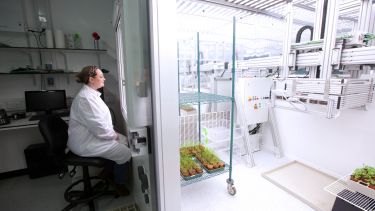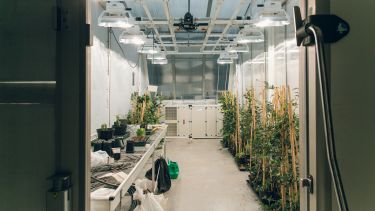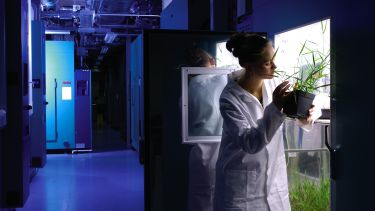Facilities
Our next-generation research facilities allow us to make groundbreaking discoveries and deliver real-world solutions to achieve food security.

The Wolfson Centre for Disease Phenomics
A state-of-the-art facility for plant disease phenomics.
Crop plants are grown in controlled environments – this enables rapid selection of new varieties with improved resistance to plant pathogens, in both current and future climate scenarios.
The facility utilises a multidisciplinary approach, from high-throughput scanners (chlorophyll fluorescence, multispectral and thermal) to image plant structure and function with metabolomics and genomics to study plant and pathogen biochemistry and genetics.
biOMICS
The Biological Mass Spectrometry Facility (biOMICS) at the University of Sheffield uses groundbreaking mass spectrometry to accelerate protein and metabolite research. Our biOMICS team of scientists has a broad background of mass spectrometry and biochemistry, molecular biology and cell biology, spanning a diverse range of biological specialties.
Members of the biOMICS team are available to help ensure a successful project through sound guidance from sample preparation all the way through to data analysis and interpretation.
The NERC Environmental Omics Facility
The NERC Environmental Omics Facility aims to make advanced molecular genetics facilities and training available to the UK community in the science areas that fall under the remit of the Natural Environment Research Council (NERC).
The Arthur Willis Environment Centre
The Arthur Willis Environment Centre provides a state-of-the-art Grodome in which individual units can be used to simulate plant growth conditions for different regions around the globe, as well as future climate scenarios. It contains dedicated laboratory, office and meeting room space to enable researchers to investigate the wide variety of environmental challenges facing the planet.
The greenhouse is designed to be energy efficient. The cooling/heating system allows the creation and maintenance of specific environmental conditions, allowing researchers to investigate the impact of present and future climate change.
A wide range of topics are studied at the centre. These include investigations aimed at understanding social insect behaviour and pathology, the role of symbiotic fungi in plant interactions, and research into improving crop plants. For example, researchers are collaborating with groups in Africa to improve resistance of rice and maize to Striga, a major hinderance to crop development in many developing nations. Other groups are working on an international project (funded by the Bill and Melinda Gates Foundation) to improve the yield of rice. Such work has the potential to have a major impact on world food security.
This unit (the result of a £4.5 million investment by the University of Sheffield) was officially opened in May 2009 and is named after Arthur Willis, the late Emeritus Professor of Botany.
Sir David Read Controlled Environment Facility
The Sir David Read Controlled Environment Facility is a world-leading climate controlled plant growth facility. The individual units are independently able to simulate the majority of terrestrial environments from tropical to polar regions as well past and future global atmospheric environments including elevated and sub-ambient CO2.
These revolutionary facilities provide the basis for Sheffield’s groundbreaking contributions to world food security research. Opened in 2004, the Sir David Read Controlled Environment Facility is the culmination of a £10.4 million investment by the Joint Infrastructure Fund.
An infrastructure investment of £3.6 million in 2016-17 has led to the installation of a further 22 state-of-the-art controlled environment chambers and rooms. Based in both the Sir David Read Controlled Environment Facility and the Arthur Willis Environment Centre, these are equipped with the very latest technologies and the ability to track worldwide weather stations.
The Department of Animal and Plant Sciences has been awarded £829,000 by the Salix Energy Efficiency Scheme. The funding will be used to replace the existing plant growth lighting with state-of-the-art LED lighting which, as well as requiring much less energy, will provide a range of research benefits. The enhanced lighting will give a spectral composition as close as possible to that of natural sunlight, mimicking sunrise/sunset conditions and promoting shading responses. The LED bars allow high light intensities of up to 2100 umol m-2 s-1. By upgrading the growth room control systems, the facility will be able to accurately track weather conditions from different parts of the planet and can use climate data from historical and modelled weather systems. The investment will reduce the energy expenditure and carbon footprint of the Sir David Read Controlled Environment Facility significantly, by £166,000 and 455 tonnes of CO2 per year, respectively.
Contact
Get in touch to find out more: sustainablefood@sheffield.ac.uk




